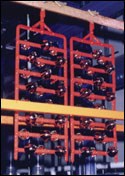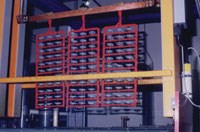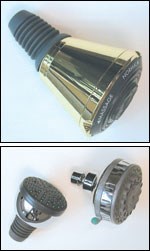New Plastics Plating Technology for 100-Year-Old Company
When Hansgrohe installed a plastics plating line, it tried to work with the newest and most advanced chemistry on the market; however, it found it couldn't simply take something off-the-shelf and start running. It had to be tailored to its specific products and objectives...
When you buy a new car, you expect it to be equipped with the latest technology: navigational system, power everything, alloy wheels, etc. However, you customize it with options that harmonize with your driving style. This may include leather seats, multiple CD player and a sunroof. You don't simply buy it off-the-shelf as you would a power saw or pack of light bulbs. You want the newest and the best, tailored to your transportation and personal requirements.
So it was at Hansgrohe, Inc. (Alpharetta, GA) when it decided to install a plastics plating line. The 100-year-old German company had ventured in the United States five years earlier, establishing a distribution facility in Georgia for its kitchen and bath fixtures. Gradually the company added assembly and eventually manufacturing as its U.S. business grew. Plating the ABS plastic showerheads molded at the company was a logical step in the company's growth.
Installing the new line was all part of Hansgrohe's plans for better quality control over its products. It started when the company began molding its own plastic components. Not only does it mold the ABS plastic pieces that are plated, but it also molds the internal components. By doing the molding in-house, the company has control over keeping the molds' surface highly polished. This eliminates any flow lines, parting lines, or pores that could affect subsequent plating.
The first finishing operation installed at the company was physical vapor deposition (PVD). This process is applied to both metal and plastic parts. A decorative "polished brass" finish is applied to showerheads and faucets. Parts are loaded into one of two vacuum chambers. A benefit to having two units is that one can be used for metal and the other plastic, as they run at different temperatures. The units are vertical, with the target source in the center. Parts are racked so that they revolve around the target source. Deposition rates are rapid. Film thickness ranges from 300Å to a few mils, depending on specifications.
Even though PVD was available in-house, parts were sent out to job shops for plating. The parts were plated acceptably, but the company wanted more control over the process. That was when it decided to bring plastics plating in-house. The company did not simply purchase plastic plating equipment and chemistry off-the-shelf, however. Kevin Wynschenk, plating manager knew that for Hansgrohe to maintain its reputation for quality and keep growing, it needed the best plastics plating technology on the market.
First he looked to the parent company in Germany to observe its manufacturing and plating methods. However, its plating operations were not the newest and the best for Hansgrohe's operations in the United States...at least as far as Mr. Wynschenk was concerned. He wanted to tweak the plating lines to suit the Alpharetta plant's operations. Also, the chemistry was traditional plating on plastics chemistry, and he knew that there were newer, more efficient products on the market. The plan was to integrate the equipment with a newer plastics plating chemistry. Enthone Inc. Although Mr. Wynschenk was comfortable with the ins and outs of decorative nickel chromium plating on metal since he had worked in plating shops for several years, he wasn't as familiar with plating on plastics. He understood the basic technology, but relied on his supplier, Enthone Inc., to ensure that the process fit with the growth and quality image Hansgrohe was establishing in the U.S. Enthone Inc. was up for the challenge, particularly since this would be the first U.S. installation using its new Ionogen and Monolith(r) plastics plating technologies.
First, Hansgrohe worked with LPW Equipment to design the new plastics plating line for growth. Even though space was limited, several gaps were left in the U-shaped line in anticipation of additional plating and rinse tanks.
The chemistry integrated into the plating line also allowed for a smaller equipment setup and less investment, since less tanks were needed, even though throughput could be increased up to 15% compared to line running traditional chemistry. Fewer tanks are needed because no hexavalent chromium is used in the activator step. There is no need for a neutralization step to reduce the hexavalent chromium to trivalent chromium. Parts are transported directly into the accelerator. Also, no copper is used on the line, eliminating the need for copper plating tanks. Because there are less tanks and fewer plating processes, it naturally follows that throughput is increased.
The crossbar of the U serves as the transfer station on the line. The line is fully automated, with operators simply having to use a touch screen to identify the parts and quantity. The system automatically does the rest, controlling amperage, tank time, current density, solution level and temperature. Some chemical additions are also automated, such as nickel brighteners, carrier and electroless nickel additives.
Special features of the plating equipment include a special rinse station at the end of the product line. The Kavitec rinsing system has bars that cycle up and down with jetties to force water into recessed areas of the parts. The drying system, Boratec, is set up in a similar fashion using hot air. The air jets can be individually programmed to cycle on and off, or pulse, for a programmed period of time. "It makes for much more thorough, spot-free drying," commented Mr. Wynschenk.
But the plastic plating chemistry is what is really unique to Hansgrohe line. "At first we did simply install the supplier's standard technology," stated Mr. Wynschenk. "But we soon found that even the newest and most advanced technology needed to be tweaked to fit our process, products and ideas of how things needed to be done." Once the plating chemistry was "in place," full production began.
A typical cycle begins after parts are molded and cured for 48 hrs. The first step in the plating process is an etchant specially designed for use with ABS plastics. The etchant uses sulfuric and chromic acid and water as well as 10 mg/liter of palladium to prepare the plastic surface for an activator step that follows. The activator also uses sulfuric and chromic acid and palladium and is specifically developed for ABS plastics. Parts processed in the solution acquire a fine dispersion of palladium that is diffused in the etched plastic surface. This palladium catalyzation initiates nickel deposition when the parts enter the subsequent electroless nickel solution.
However, parts do not go directly from this step into the electroless nickel.
There is one more step prior to electroless nickel plating. Parts are first immersed in an accelerator that reduces palladium diffused on the surface. This ensures that the electroless nickel deposition will be fast and uniform.
The electroless nickel was not part of the original "standard" plastic plating system offered. However, the original offering did not work with Hansgrohe's system. After much experimentation and long hours, the suppliers and plating technicians at Hansgrohe came up with the electroless nickel solution. "Using an all nickel system instead of copper has several advantages," noted Mr. Wynschenk. "The biggest advantage is in the waste treatment area. Because our wastewater isn't contaminated with copper, we can separate our streams into one for nickel and one for chromium and recycle it. We also benefit because the finished product has a much harder finish than if we had used copper. We have run a number of performance tests, such as neutral salt spray and wear resistance tests, and the all-nickel process outperforms the copper." The all-nickel system also offers improved thermal shock performance, an important attribute when considering the nature of Hansgrohe's products.
The only disadvantage of note, as Mr. Wynschenk sees it, is that you have to start with a "perfect" part. "Copper has the ability to cover flows lines, pits and other imperfections. But since we have control of the molding process, that isn't really a problem here at Hansgrohe," he noted.
| TABLE I-Plating Processes | |||||
| Process |
Temp. (F)
|
Time (min)
|
Sp. Gravity
(at 68F) |
Agitation
|
pH |
| Etchant (Udique BL 2010) |
160
|
10-20 |
1.450 g/cm ³ |
air/cathode rod
6-9 fpm |
|
| Activator (Udique BL 2110 MS) |
ambient | 3-5 | 1.016 g/cm ³ |
air-cathode rod
6-9 fpm |
|
| Accelerator (Udique BL 2210) |
90 | 3-5 | 0.947 g/cm ³ |
no air/work movement 7-12 fpm
|
|
| Electroless Nickel (Udique 891) |
85 | 6 |
mechanical
|
6.5 |
|
| Electrolytic Nickel (Elpelyt Monolith) |
117 | 1 µ/min | 1.35 g/cm ³ |
vert/horz work movement or air
|
9 |
| Bright Nickel (Elpelyt LS 1) |
140-144 | 1 µ/min | 1.20 g/cm ³ |
vert/horz work movement or air
|
3.8 |
| Nickel Activator (Ankor NFDS) |
ambient | 40 sec | 1.0 g/cm ³ |
none
|
4.2 |
| Bright Chromium (Ankor 1120 H) |
105 | 4.7µ/min | 1.125 g/cm ³ |
|
|
The electroless nickel process deposits a smooth, continuous coating on the activated plastic showerheads and faucets. It is a low-temperature operation, running at about 90F. Electroless nickel plating is followed by the "Monolith" prior to bright nickel plating.
The Elpelyt Monolith electrolytic nickel-plating process for plastics is a multiple-additive nickel process that also serves as a substitute for the copper in the plating process. The nickel deposits are ductile, which is important for these products, considering the subsequent assembly they go through. After the plating process is complete, additional plastic components are added to the interior of the parts, along with hoses and fittings. Also, additional exterior parts are added such as nozzles, sprays and adjustment components, such as those used to reconfigure the spray pattern for normal spray, soft spray or a massage spray.
The next step is bright nickel plating in Elpelyt LS 1. This is a multiple additive bright nickel plating process that provides for excellent chromium receptivity. Following that is a nickel activator prior to chromium plating.
The electrolytic (cathodic) activator replaces activating parts in sulfuric acid, thus preventing milky chromium films and stains that can result from passive bright nickel deposits due to insufficient rinsing or prolonged periods between nickel and chromium plating.
The final plating process is bright chromium plating with Ankor 1120 H. This process is based on a mixed acid chrome electrolyte. It provides excellent coverage over a range of operating current densities. Despite lower concentrations of chrome versus a conventional chrome plating solution, this process offers good tolerance to contaminants while also providing improved throw and coverage.
The bath is followed by the Kavitec rinse cycle and Boratec drying system described previously.
Once plated, parts are sent on for in-house assembly and packaging. Hansgrohe's parts are sold in stores such as Home Depot under the name Monsoon, among others. One of the interesting aspects of the company is that it allows you to try out its high-end products prior to purchase. You can shower at the facility in Alpharetta under a number of different shower panels. There are panels that have hand showers and body showers and temperature controls with integrated thermostats so that when someone starts the washing machine you aren't scalded or left with goose bumps! These are just some of the products Hansgrohe has developed.
The company is constantly developing and broadening its product line. In June the company plans to triple the capacity of its plastics plating line. It will also add another plating line for plating brass faucets with a "brushed nickel finish." "This will bring more of the plating in-house and give us more control over quality," said Mr. Wynschenk. "Of course we will also have to expand our waste treatment facility to handle the expansion. We are currently only using about 4,000 gpd."
What really sets Hansgrohe apart, however, cannot be derived from a list of features, processes or marketing claims. It is the feel of the product that makes the difference. It is a feel of surpassing excellence, of superb fit, finish and function . . . a feel that makes the shower the best part of the day.
Related Content
Successful South African Plater Beating the Odds
Remaining focused on quality and reliability, Team Plating Works stays profitable in a volatile and challenging economy.
Read MoreHow to Choose Between Sulfate and Chloride-Based Trivalent Chromium
There are several factors to consider when choosing between sulfate and chloride-based baths for trivalent chromium plating. Mark Schario of Columbia Chemical discusses the differences and what platers should keep in mind when evaluating options.
Read MoreTrivalent Chrome Overview
As the finishing industry begins to move away from the use of hexavalent chromium to trivalent chromium, what factors should finishers consider as they make new investments? Mark Schario, chief technology officer for Columbia Chemical offers a helpful overview of this complicated topic.
Read MoreA Chromium Plating Overview
An overview of decorative and hard chromium electroplating processes.
Read MoreRead Next
Delivering Increased Benefits to Greenhouse Films
Baystar's Borstar technology is helping customers deliver better, more reliable production methods to greenhouse agriculture.
Read MoreEducation Bringing Cleaning to Machining
Debuting new speakers and cleaning technology content during this half-day workshop co-located with IMTS 2024.
Read MoreA ‘Clean’ Agenda Offers Unique Presentations in Chicago
The 2024 Parts Cleaning Conference, co-located with the International Manufacturing Technology Show, includes presentations by several speakers who are new to the conference and topics that have not been covered in past editions of this event.
Read More















.jpg;maxWidth=300;quality=90)










